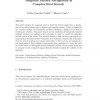Free Online Productivity Tools
i2Speak
i2Symbol
i2OCR
iTex2Img
iWeb2Print
iWeb2Shot
i2Type
iPdf2Split
iPdf2Merge
i2Bopomofo
i2Arabic
i2Style
i2Image
i2PDF
iLatex2Rtf
Sci2ools
IJON
2008
2008
Topos: Spiking neural networks for temporal pattern recognition in complex real sounds
This article depicts the approach used to build the Topos application, a simulation of two-wheel robots able to discern real complex sounds. Topos is framed in the nouvelle concept of subsymbolic artificial intelligence, applied to the field of evolutionary robotics. This paper focuses on the simulation of biologically inspired artificial cochleas and spiking neural networks, in order to model the embodied control system of the robots. The method chosen to find the most appropriate parameters that determine robots' behaviour is evolutionary computation techniques, with the aim of avoiding any human intervention in this task. As an example of a real application of this technique, experiments were performed to study the ability of the robots to distinguish sounds composed of parts of real canary songs and to navigate to the recognised signal. Results obtained confirm the validity of the approach. Key words: Evolutionary Robotics, Spiking Neural Networks, Sound Perception, Sensorimo...
| Added | 25 Jan 2011 |
| Updated | 25 Jan 2011 |
| Type | Journal |
| Year | 2008 |
| Where | IJON |
| Authors | Pablo González-Nalda, Blanca Cases |
Comments (0)

